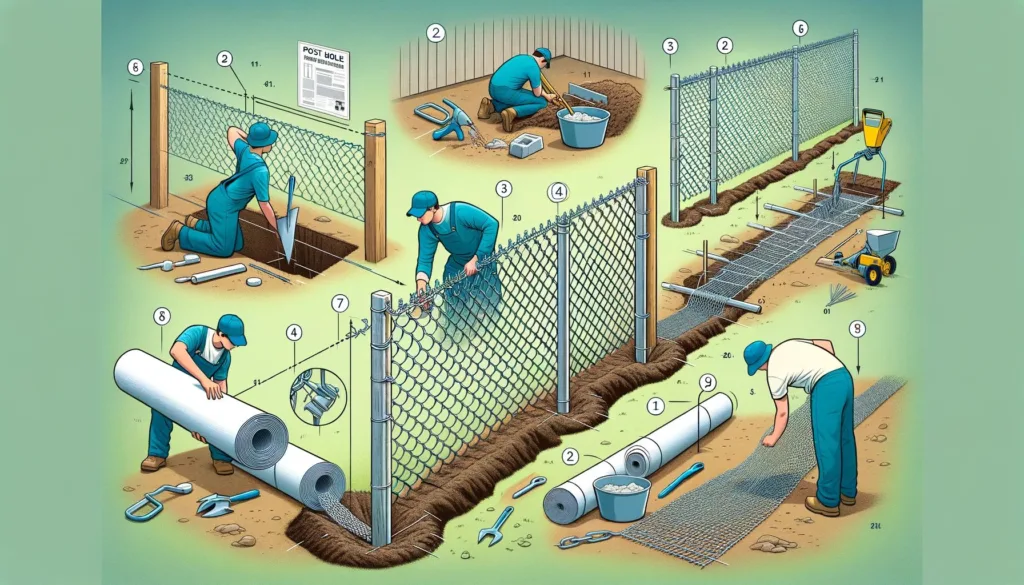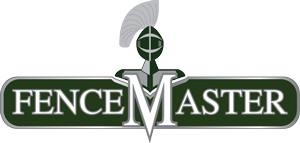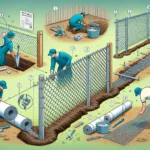Installing a chain link fence can be a rewarding DIY project that offers both security and aesthetic benefits to your property. Whether you want to keep pets contained, enhance your home’s security, or simply mark your property boundaries, a chain link fence is a versatile and durable option. While the idea of installing a fence might seem daunting, with the right tools and a bit of guidance, it’s a task that can be tackled by most homeowners.
II. Preparing for Installation
Before diving into the installation process, it’s crucial to prepare adequately. Start by planning and measuring the area where you want to install the fence. This ensures you purchase the right amount of materials and avoid unnecessary complications. Additionally, gather all the necessary tools and materials beforehand. Don’t forget to check local regulations and permits – some areas have specific rules regarding fence installations.
III. Choosing the Right Materials
The type of chain link fence you choose will depend on your specific needs. There are different heights and gauges available, each suited for different purposes. For instance, a higher gauge is ideal for enhanced security, while a lower gauge might be sufficient for a garden fence. Selecting quality materials will ensure your fence is sturdy and long-lasting.
IV. Tools You Will Need
To install a chain link fence, you’ll need a variety of tools. Essential tools include a post hole digger, shovel, level, tape measure, and pliers. Optional tools like a power auger can make the job easier and faster, especially if you’re installing a large fence.
V. Step-by-Step Installation Guide
A. Marking the Fence Line
Begin by marking the fence line using stakes and string. This will help you visualize the fence’s path and ensure it’s straight.
B. Digging Post Holes
Next, dig the post holes. The depth and spacing of the holes are crucial for the stability of the fence. Typically, holes should be at least 2 feet deep and spaced 6-10 feet apart.
C. Setting the Posts
Mix and pour concrete into the post holes, then insert the posts. Make sure the posts are aligned and level as the concrete sets. This step is vital for the structural integrity of the fence.
D. Attaching the Fence Fabric
Once the posts are set, unroll the chain link fabric and attach it to the posts. Use tension bars and bands to secure the fabric, ensuring it’s tight and even.
E. Installing Gates
If your fence includes a gate, install it last. Choose a gate size that fits your needs and follow proper installation techniques to ensure it operates smoothly.
VI. Tips for a Successful Installation
Avoid common mistakes such as incorrect measurements or uneven post spacing. Ensuring that the posts are firmly set in concrete and the fabric is properly tensioned will contribute to a sturdy, long-lasting fence. Regular maintenance, like tightening loose sections and checking for rust, will keep your fence in top condition.
VII. Benefits of Installing a Chain Link Fence
Chain link fences offer numerous benefits. They provide security, keeping pets and children safe within your yard. They’re cost-effective, especially if you install them yourself, and they require minimal maintenance. Additionally, their durability and versatility make them suitable for various applications, from residential to commercial use.
VIII. Cost Analysis
One of the biggest advantages of installing a chain link fence yourself is the cost savings. Professional installation can be expensive, but by doing it yourself, you can significantly cut down on labor costs. However, it’s important to consider the cost of materials and tools, as well as the time investment.
IX. Troubleshooting Common Issues
Installing a fence on uneven terrain can be challenging. Adjusting the height of the posts and ensuring the fabric follows the ground’s contour can address this issue. If you encounter loose posts or sagging fabric, reinforcing the posts and re-tensioning the fabric can help.
X. Conclusion
Installing a chain link fence yourself is a manageable task that can save you money and give you a sense of accomplishment. By following the steps outlined above and paying attention to detail, you can create a sturdy, attractive fence that meets your needs. Whether you’re enhancing your home’s security or adding a boundary to your property, a DIY chain link fence is a worthwhile project.
XI. FAQs
- What is the average time to install a chain link fence?
The time it takes to install a chain link fence depends on the size of the area and the complexity of the terrain. On average, it can take a weekend for a small to medium-sized yard. - Can I install a chain link fence on a slope?
Yes, installing a chain link fence on a slope is possible. Adjust the post heights and ensure the fabric follows the contour of the ground. - How deep should fence posts be set?
Fence posts should typically be set at least 2 feet deep to ensure stability. - What are the maintenance requirements for a chain link fence?
Chain link fences require minimal maintenance. Regularly check for loose sections, rust, and ensure the posts remain firm in the ground. - Is a chain link fence suitable for all climates?
Yes, chain link fences are durable and can withstand various weather conditions, making them suitable for most climates.



